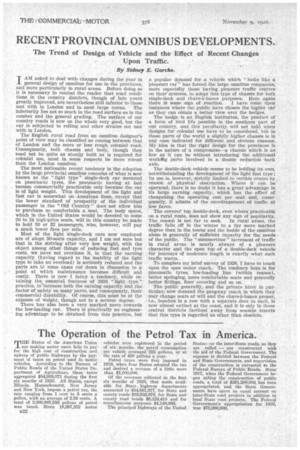RECENT PROVINCIAL OMNIBUS DEVELOPMENTS.
Page 112

If you've noticed an error in this article please click here to report it so we can fix it.
The Trend of Design of Vehicle and the Effect of Recent Changes Upon Traffic.
By Sidney E. Garcke, T AM asked to deal with changes during the year in 1 general design of omnibus for use in the provinces, and more particularly in rural areas. Before doing so it is necessary to remind the reader that road conditions in the country districts, though of late years greatly improved, are nevertheless still inferior to those met with in London and in most large towns. The inferiority lies not so much in the road surface as in the camber and the general grading. The surface of our country roads is now on the whole very good, but the car is subjected to rolling and other strains not met with in London.
The English rural road from an omnibus designer's point of view may be classified as coming between that of London and the more or less rough colonial road. Consequently, both chassis and body, though they need not be quite as stoutly built as is required for colonial use, must in some respects be more robust than the London omnibus.
The most noticeable recent tendency is the adoption by the large provincial omnibus concerns of what is now known as the "light type" single-deck car mounted on pneumatic tyres, the pneumatic having at last become commercially practicable only because the car is of light weight. This development of the light and fast car, is somewhat on American lines, except that the lower standard of prosperity of the individual passenger in the "Old Country" does not allow him to purchase so comfortable a seat. The body space, which in the United States would be devoted to some 20 to 24 high-price seats, will in this country be made to hold 30 or 32 passengers, who, however, will pay a much lower fare per mile.
Most of the light single-deck cars now employed are of abqut 30-seats capacity, and I am not sure but that in the striving after very low weight, with the object among other things of reducing fuel and tyre costs, we nave not overdone it, in that the earning capacity. (having regard to the inability of the light type to take an overload) is seriously reduced and the parts are io some cases cut down in dimension to a point at which maintenance becomes difficult and costly. There is now I fancy a tendency, while retaining the essential features of 1926 "light . type " practice, to. increase both the earning capacity and the factor of safety on many parts, and consequently, their commercial durability. Of course, this must be at the expense of weight, though not to a serious degree.
There has also been a very marked move towards the low-loading car. There is practically no engineering advantage to be obtained from this practice, but
a popular demand for a vehicle which "looks like a pleasure car." has forced the large omnibus companies,more especitly those having pleasure traffic centres on their' systems, to adopt this type of chassis for both single-deck and chars-h-bancs purposes. Here again there is some sign of reaction. have come upon instances where the public have chosen the higher car as they can obtain a better view over the hedges.
The hedge is an English institution, the product of a form of bird life possible in the southern part of our country, and this peculiarity will not hold when designs for colonial use have to be considered, but in those parts of the world a slightly higher chassis is in any case indicated for different and obvious reasons. My idea is that the right design for the provinces is in the nature of a compromise—a chassis which is as Tow as it can be without introducing the additional workg parts involved in a double reduction back axle.
The double-deck vehicle seems to be holding its own, notwithstanding the development of the light fast type; its use is, however, strictly limited to certain routes by reason of physical obstruction. Where it can be operated, there is no doubt it has a great advantage in its large earning capacity, which has the effect of cheapening the operating cost per seat and, consequently, it admits of the encodragement of traffic at low fares.
The covered top double-deck, even where practicable on a rural route, does not show any sign of popularity. The reasoil is not far to seek. In rural areas, the traffic falls off in the winter to a far more marked degree than in the towns and the inside of the omnibus alone is generally of sufficient capacity for the needs of the public. The " aimmertime " increment of traffic in rural arms is nearly always of a pleasure character and the open top of a double-deck vehicle for journeysof moderate length is exactly what such traffic wants.
To complete my brief survey of 1926, I have to touch upon the open motor coach. The tendency here is for pneumatic tyres, low-loading line (within reason), better springing, more comfortable seats and generally better fittings, floor covering and so on.
The public generally, and the private hirer in particular; now demand the gangway coach in which they may change seats at will and the chars-h-bancs proper, • i.e., benches in a row with a separate door to each, is now almost extinct at the coast, and it is only in those central districts farthest away froiv seaside resorts that this type is regarded as other than obsolete.












































































































































































































